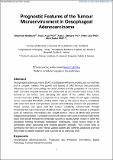Files in this item
Prognostic features of the tumour microenvironment in oesophageal adenocarcinoma
Item metadata
| dc.contributor.author | McShane, Rhiannon | |
| dc.contributor.author | Arya, Swati | |
| dc.contributor.author | Stewart, Alan J. | |
| dc.contributor.author | Caie, Peter David | |
| dc.contributor.author | Bates, Mark | |
| dc.date.accessioned | 2022-07-28T23:47:11Z | |
| dc.date.available | 2022-07-28T23:47:11Z | |
| dc.date.issued | 2021-12 | |
| dc.identifier | 275215595 | |
| dc.identifier | 22207994-4b74-4209-9c94-527996909b2f | |
| dc.identifier | 85112820265 | |
| dc.identifier | 000697158300013 | |
| dc.identifier.citation | McShane , R , Arya , S , Stewart , A J , Caie , P D & Bates , M 2021 , ' Prognostic features of the tumour microenvironment in oesophageal adenocarcinoma ' , Biochimica et Biophysica Acta - Reviews on Cancer , vol. 1876 , no. 2 , 188598 . https://doi.org/10.1016/j.bbcan.2021.188598 | en |
| dc.identifier.issn | 0304-419X | |
| dc.identifier.uri | https://hdl.handle.net/10023/25748 | |
| dc.description | The work relevant to this review is in part supported by grants from the Irish health research board (HRB-ILP-2017-055) and the Irish Association for Cancer Research (AOIFA-14873). | en |
| dc.description.abstract | Oesophageal adenocarcinoma (OAC) is a disease with an incredibly poor survival rate and a complex makeup. The growth and spread of OAC tumours are profoundly influenced by their surrounding microenvironment and the properties of the tumour itself. Constant crosstalk between the tumour and its microenvironment is key to the survival of the tumour and ultimately the death of the patient. The tumour microenvironment (TME) is composed of a complex milieu of cell types including cancer associated fibroblasts (CAFs) which make up the tumour stroma, endothelial cells which line blood and lymphatic vessels and infiltrating immune cell populations. These various cell types and the tumour constantly communicate through environmental cues including fluctuations in pH, hypoxia and the release of mitogens such as cytokines, chemokines and growth factors, many of which help promote malignant progression. Eventually clusters of tumour cells such as tumour buds break away and spread through the lymphatic system to nearby lymph nodes or enter the circulation forming secondary metastasis. Collectively, these factors need to be considered when assessing and treating patients clinically. This review aims to summarise the ways in which these various factors are currently assessed and how they relate to patient treatment and outcome at an individual level. | |
| dc.format.extent | 21 | |
| dc.format.extent | 2656054 | |
| dc.language.iso | eng | |
| dc.relation.ispartof | Biochimica et Biophysica Acta - Reviews on Cancer | en |
| dc.subject | Oesophagel adenocarcinoma | en |
| dc.subject | Prognostic and predictive biomarkers | en |
| dc.subject | Digital pathology | en |
| dc.subject | Tumour microenvironment | en |
| dc.subject | RB Pathology | en |
| dc.subject | RC0254 Neoplasms. Tumors. Oncology (including Cancer) | en |
| dc.subject | SDG 3 - Good Health and Well-being | en |
| dc.subject.lcc | RB | en |
| dc.subject.lcc | RC0254 | en |
| dc.title | Prognostic features of the tumour microenvironment in oesophageal adenocarcinoma | en |
| dc.type | Journal item | en |
| dc.contributor.institution | University of St Andrews. Cellular Medicine Division | en |
| dc.contributor.institution | University of St Andrews. School of Medicine | en |
| dc.contributor.institution | University of St Andrews. Sir James Mackenzie Institute for Early Diagnosis | en |
| dc.contributor.institution | University of St Andrews. Institute of Behavioural and Neural Sciences | en |
| dc.contributor.institution | University of St Andrews. Biomedical Sciences Research Complex | en |
| dc.contributor.institution | University of St Andrews. Centre for Biophotonics | en |
| dc.identifier.doi | 10.1016/j.bbcan.2021.188598 | |
| dc.description.status | Peer reviewed | en |
| dc.date.embargoedUntil | 2022-07-29 |
This item appears in the following Collection(s)
Items in the St Andrews Research Repository are protected by copyright, with all rights reserved, unless otherwise indicated.

